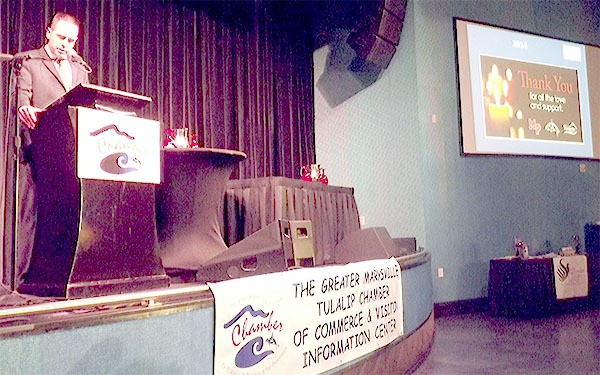By Chris Winters, Herald Writer
There was the usual news about the city’s projects and finances: “Not flush with cash, but it is healthy,” Nehring told the Greater Marysville Tulalip Chamber of Commerce on Friday.
But 2014 in Marysville was defined by one event that caught everyone by surprise, the Oct. 24 shootings at Marysville-Pilchuck High School.
“It really was something that transformed our community. I don’t think anyone expects this kind of thing to happen,” Nehring said.
The shootings left five students dead, including the shooter. One student, Nate Hatch, survived and has become an inspiration to the community, Nehring said.
What Nehring was most impressed with was the response of all the police, firefighters, hospital personnel, city, school and tribal leaders who all rallied together after the shootings.
“From day one, we got out and said we’re standing as one community in this,” Nehring said.
Coming together as a community was an underlying theme of Nehring’s address, from the many projects that were completed in 2014 to initiatives planned for the coming year.
Marysville citizens approved by double-digit margins a 0.2 percent sales tax increase in 2014 that will fund nearly $2 million in critical road repairs over the next decade.
Community input led to the idea to build a North Annex police building to allow officers to better serve the north part of the city. The annex opened in 2014.
The city’s Stay Out of Drug Areas ordinance covers the downtown core — about five percent of the city’s area. It was coupled with a cross-departmental initiative and community outreach. It reduced downtown crime by nearly 20 percent, Nehring said.
The downtown area “used to represent twenty percent of the crime in our city, if you can imagine that,” he said.
Building the Spray Park in Comeford Park was another success story, attracting 38,000 people over the summer and injecting new life into what had been an underused facility that used to draw drug dealers and other undesirables.
The newly opened Doleshel Park was one more example of city and community working together, he said. The former tree farm was transformed over three years largely by volunteer labor from the local Mormon community.
Other projects moving forward in 2015 include the Qwuloolt Trail, an interpretive trail along the banks of Ebey Slough being built along with the Tulalip Tribes’ Qwuloolt Estuary Restoration Project; and the $35 million project to expand the interchange of Highway 529 and I-5. The interchange project recently received $5 million in committed construction funds, and most of the permitting is expected to be completed this spring, Nehring said.
He returned to law enforcement, to note the early success of the Regional Property Crime Task Force, a collaborative effort between the cities of Marysville and Lake Stevens, Snohomish County and the Stillaguamish Tribe. The task force made five arrests in its first week, he said.
The city had a scare on Oct. 15, when a Granite Falls man went on a shooting rampage through that town, Lake Stevens and Marysville, targeting police. Marysville Sgt. Jim Maples was injured by shrapnel, before the suspect was shot and arrested.
“When I listen to that 911 call, in this chaos when this guy is going through the city shooting hundreds of bullets…,” Nehring said, “the amount of calm and professionalism that came across from our police officers was truly amazing.”
It was that professionalism that came into play nine days later at Marysville Pilchuck, when the first police were on the scene within two minutes. Ultimately more than 120 police and rescue workers rushed to the scene to try and save the lives of the injured students and keep everyone else safe.
Nehring asked those assembled Friday to keep the families of the victims in their thoughts.
“They have a longer and infinitely more difficult road back than the rest of us. Please remember them,” he said.



